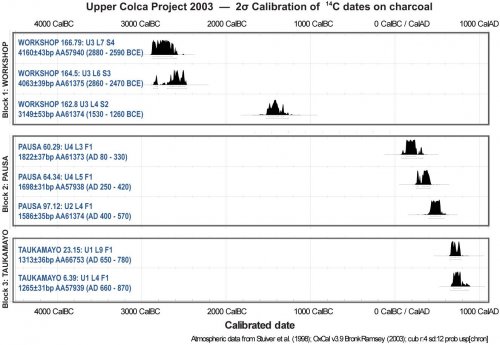7.3. Test excavation units
In the course of fieldwork in 2003 test excavations were conducted in Blocks 1, 2, and 3 of the study area. The excavations complied with the stipulations of the survey and test-excavation permits acquired from the Peruvian Instituto Nacional de Cultura. The research plan involved excavating a number of 1x1m units in different areas of the three intensive survey blocks, as per the limitations of the test excavation permit. Excavation methods were described in Section 5.6.1. The focus in this chapter is on presenting the results of excavation in the five test units together with evidence most relevant to the larger research project.
|
2002 Site |
Test Unit |
Block |
2003 Provenience |
Description |
Total 2scalibrated date range |
|
Q02-2 |
1 |
1 |
A03-201 "Saylluta 2" |
Corral |
Samples not analyzed |
|
Q02-2 |
2 |
1 |
A03-219 "Quarry Pit" |
Quarry debris pile |
No datable materials: inferred to be largely Early Formative |
|
Q02-2 |
3 |
1 |
A03-330 "Maymeja" |
Maymeja workshop |
Term. Archaic - E/M Formative: 2880 - 1260 BCE |
|
A02-26 |
1 |
3 |
A03-675 "Taukamayo" |
Edge of landslide |
Tiwanaku: AD 650 - 870 |
|
A02-39 |
1 |
2 |
A03-559 "Pausa" |
Raised corral area |
No datable materials |
|
A02-39 |
2 |
2 |
A03-557 "Pausa" |
Raised corral area |
Early Tiwanaku: AD 400 - 470 |
|
A02-39 |
3 |
2 |
A03-559 "Pausa" |
Raised corral area |
Late Formative: AD 80 - 420 |
|
A02-39 |
4 |
2 |
A03-559 "Pausa" |
Raised corral area |
Late Formative: AD 80 - 420 |
Table 7-6. 1x1m test excavation unit proveniences from 2003 fieldwork.
Due to the higher resolution of the 2003 mobile GIS survey work, the proveniences of surface features were redefined from the 2002 site numbers in some cases using the locus system as per the survey results in Chapter 6. In this dissertation, the 2002 site names (Q02-2, A02-26 and A02-39) were largely used to avoid confusion, but the 2003 locus numbers of these features are provided in Table 7-6 for reference.
Radiocarbon dates were retrieved from the majority of the excavation units and eight charcoal samples were analyzed using Accelerator Mass Spectrometry14C dating at the NSF's University of Arizona AMS lab. Test excavations served the important role of providing diachronic insights into obsidian production, and testing also frequently provided temporal control in the form of14C datable charcoal
Figure 7-3. Radiocarbon dates on charcoal from test excavations in 2003 showing uncalibrated and calibrated dates as BCE from OxCal v3.9 (Ramsey 2003).
The ranges of the 2003 project radiocarbon dates unfortunately do not overlap between survey blocks, which makes it more difficult to study obsidian production activities in the three survey blocks synchronically. Nevertheless these dates provide some important controls to production activities, particularly in Block 1 workshop where Terminal Archaic through Early Formative dates were acquired.
